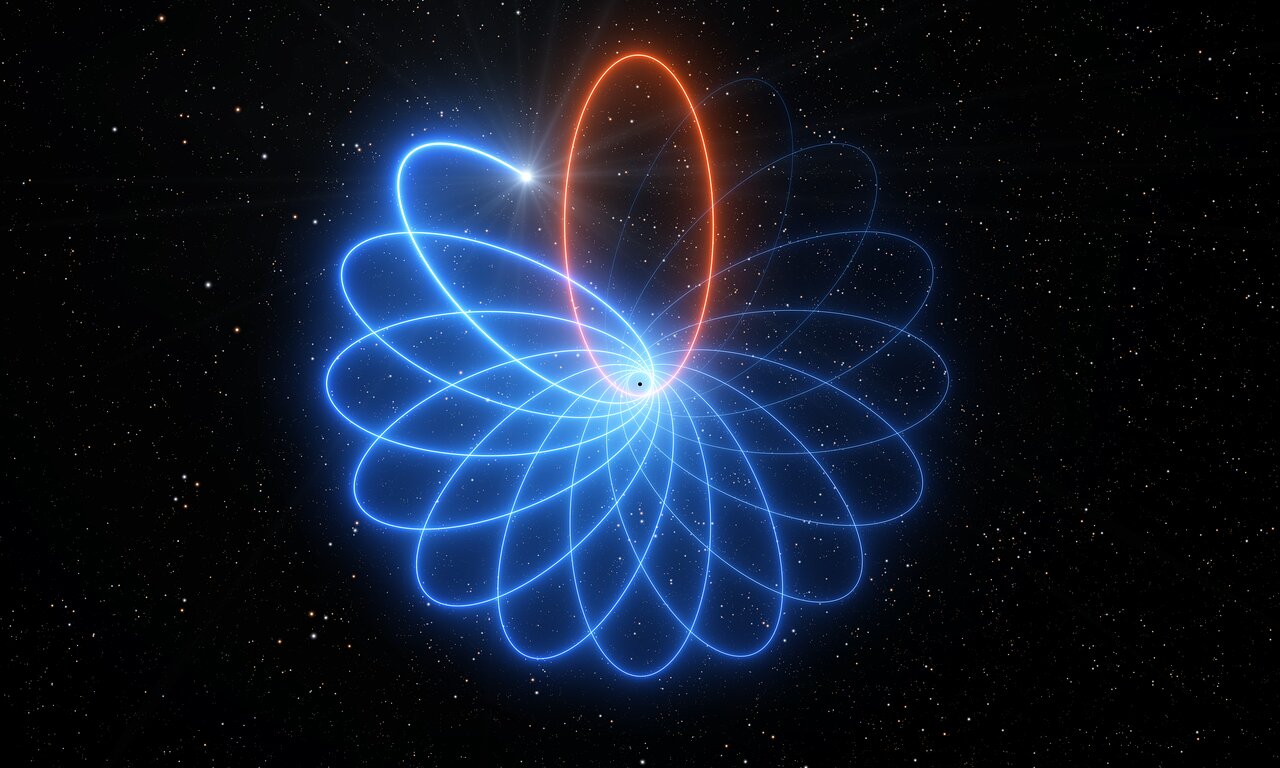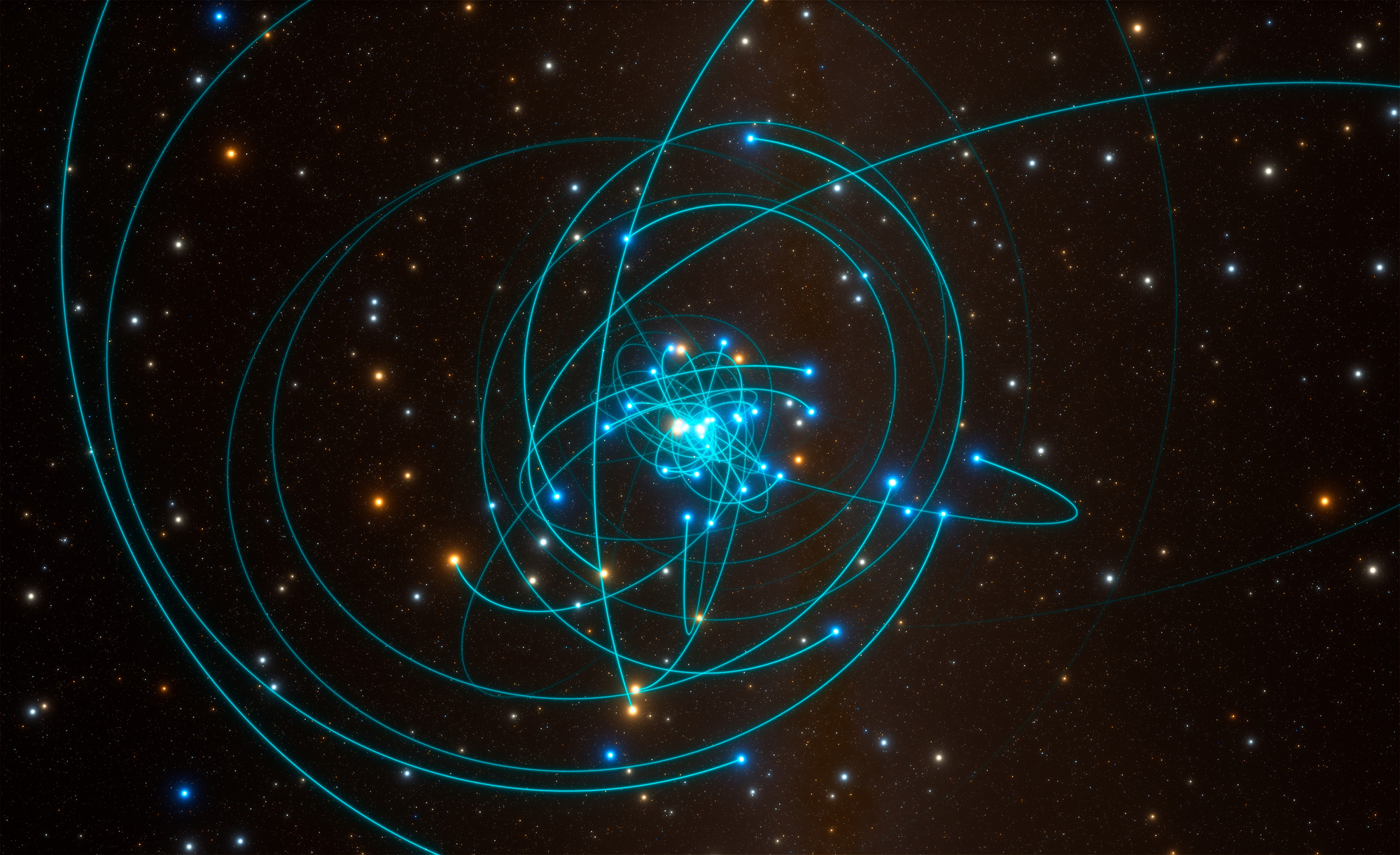Star's motion around Milky Way's monster black hole proves Einstein right yet again
Einstein's theory of general relativity just passed a dramatic black-hole test with flying colors.
The motion of a star orbiting Sagittarius A*, the supermassive black hole at the heart of our Milky Way galaxy, precisely matches that predicted by general relativity, a new study reports.
"Einstein's general relativity predicts that bound orbits of one object around another are not closed, as in Newtonian gravity, but precess forward in the plane of motion. This famous effect — first seen in the orbit of the planet Mercury around the sun — was the first evidence in favor of general relativity," study co-author Reinhard Genzel, director of the Max Planck Institute for Extraterrestrial Physics in Garching, Germany, said in a statement.
"One hundred years later, we have now detected the same effect in the motion of a star orbiting the compact radio source Sagittarius A* at the center of the Milky Way," Genzel added. "This observational breakthrough strengthens the evidence that Sagittarius A* must be a supermassive black hole of 4 million times the mass of the sun."
Related: Images: black holes of the universe

The motion Genzel mentioned, called Schwarzschild precession, describes a sort of rotation in an object's elliptical orbit. The location of the object's closest-approach point changes with each lap, so the overall orbit is shaped like a rosette rather than a simple, static ellipse.
Astronomers had never measured Schwarzschild precession in a star zooming around a supermassive black hole — until now.
Breaking space news, the latest updates on rocket launches, skywatching events and more!
The research team used the European Southern Observatory's (ESO) Very Large Telescope (VLT) in Chile to track a star called S2 as it looped around Sagittarius A*, which lies about 26,000 light-years from Earth. Over the course of 27 years, the astronomers made more than 330 measurements of S2's position and velocity using multiple VLT instruments. (One of those instruments is called GRAVITY, which gives the research team its name: the GRAVITY collaboration.)
Such a long observational window was necessary to pick up S2's precession, for the star takes 16 Earth years to complete one orbit around Sagittarius A*.
The observed precession matched the predictions of general relativity exactly, which could lead to further discoveries down the road, the researchers said.
“Because the S2 measurements follow general relativity so well, we can set stringent limits on how much invisible material, such as distributed dark matter or possible smaller black holes, is present around Sagittarius A*," team members Guy Perrin and Karine Perraut — of the Paris Observatory-PSL and the Grenoble Institute of Planetology and Astrophysics in France, respectively — said in the same statement.
"This is of great interest for understanding the formation and evolution of supermassive black holes," they added.
The new study, which was published online today (April 16) in the journal Astronomy & Astrophysics, may presage even more exciting black-hole insights to come. For example, coming megascopes such as ESO's Extremely Large Telescope could allow astronomers to track stars that get even closer to Sagittarius A* than S2 does, the researchers said.
“If we are lucky, we might capture stars close enough that they actually feel the rotation, the spin, of the black hole," said study team member Andreas Eckart of Cologne University in Germany. "That would be again a completely different level of testing relativity."
- Amazing space views of ESO's Very Large Telescope (photos)
- How did supermassive black holes get so big and chonky? Scientists still don't know.
- Albert Einstein: Biography, theories and quotes
Mike Wall is the author of "Out There" (Grand Central Publishing, 2018; illustrated by Karl Tate), a book about the search for alien life. Follow him on Twitter @michaeldwall. Follow us on Twitter @Spacedotcom or Facebook.
OFFER: Save 45% on 'All About Space' 'How it Works' and 'All About History'!
For a limited time, you can take out a digital subscription to any of our best-selling science magazines for just $2.38 per month, or 45% off the standard price for the first three months.

Michael Wall is a Senior Space Writer with Space.com and joined the team in 2010. He primarily covers exoplanets, spaceflight and military space, but has been known to dabble in the space art beat. His book about the search for alien life, "Out There," was published on Nov. 13, 2018. Before becoming a science writer, Michael worked as a herpetologist and wildlife biologist. He has a Ph.D. in evolutionary biology from the University of Sydney, Australia, a bachelor's degree from the University of Arizona, and a graduate certificate in science writing from the University of California, Santa Cruz. To find out what his latest project is, you can follow Michael on Twitter.


